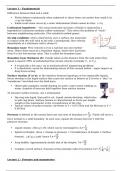Class notes
ES2C5 Dynamics and Fluid Dynamics - Complete lecture notes for the Fluid Dynamics part only
- Course
- Institution
This is a 20 page write-up of the lecture notes, covering all important equations and theories needed for the Fluid Mechanics part of ES2C5. The lecture slides themselves for ES2C5 are very chaotic, not concise, and are at times confusing. These notes aim to cut out the waffle, and provide the impo...
[Show more]



